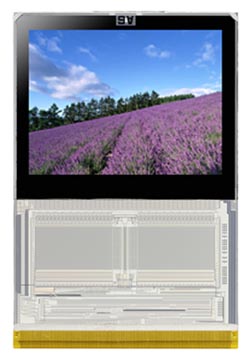NEC LCD Technologies Develops World’s First Color TFT LCD Module with DRAM Frame-Memory System Embedded Onto Glass Substrate
For immediate use May 23, 2007
NEC LCD Technologies, Ltd.

Tokyo, May 23, 2007 --- NEC LCD Technologies, Ltd. today announced development of the world’s first thin-film-transistor (TFT) liquid crystal display (LCD) prototype module with a DRAM frame memory system, corresponding to 1 8-bit color (262k colors), embedded onto the glass substrate of the LCD screen. The results of this research will be presented on May 24 at SID 2007, being held at the Long Beach Convention Center in California from May 20 to 25.
The new LCD module has been realized by a combination of NEC LCD Technologies' own unique value integrated TFT-LCD (VIT) technology and low-temperature poly-silicon (LTPS) TFT technology, and includes the following key features.
- Successful design of a system LSI onto the glass substrate of the screen, utilizing a record-breaking 400,000 transistors in the peripheral circuits. The LCD integrates the peripheral circuits, including the frame memory system that incorporates a 230k-bit DRAM and a front-end picture decoder, a picture encoder, 6-bit DAC, and a controller.
- Adoption of NEC's proprietary graphical data compression / decompression technology, smart pixel-data codec (SPC), enables a reduction in the amount of memory required to store the data of one screen image by two thirds that required by original data that doesn’t employ any kind of codec, thereby contributing to a reduction in circuit area and power consumption.
- Adoption of a RGB horizontal stripe for the pixel arrangement enables high density, a polychrome display, and optimization of cell layout of the graphics frame memory, simultaneously. This kind of pixel arrangement enables greater minimization of the circuit area on the glass substrate, which generally increases along with pixel density, as compared with RGB vertical stripe arrangements.
- The newly-developed controller enables simultaneous and independent access for writing and reading in graphics frame memory, and achieves a data transfer rate of approximately 30 frames per second, enabling smooth display of a variety of digital movie contents.
Recently, the market has seen a rapid rise in the introduction of new kinds of portable devices, such as personal digital assistants (PDAs), personal navigation devices (PNDs), smartphones and portable multimedia players (PMPs). The progression of a networked information society is concurrently creating a demand for display devices that provide a range of diverse features simultaneously, including small size, short depth, light weight, high density, high luminance, polychrome display, and low power consumption.
Accordingly, the market is seeking a reduction in the amount of display power consumption, as displays consume the greatest amount of energy in portable devices. Embedding the graphics frame memory into an LCD module is one solution as it enables preservation of the image signal transferred from the system as one set of screen data. As a result, the graphics frame memory enables screen output by reading the data preserved in the graphics frame memory when the same screen is viewed, as opposed to receiving a new image signal from the system. This realizes a significant reduction in power consumption due to reduced signal communication between the display device and the system.
Currently, graphics frame memory is realized by a COG-mounting method that attaches system-LSI chips, made on a silicon substrate, directly onto the glass substrate of the LCD. However, this poses a problem for timely manufacturing of new LCD modules as the lead time for mass production of system LSI chips is very long.
"The market is already eagerly awaiting the advancement of system-on-glass LCDs as they will eliminate the need to develop LSI chips, thereby shortening development cycles significantly, and allowing us to bring the right products to our customers and the markets faster than ever before," said Hideki Asada, Senior Manager of Research Department at NEC LCD Technologies. "Embedding the frame memory onto the glass substrate is a completely new breakthrough in system-on-glass LCD technology, and will enable significant reductions in display power consumption. This kind of new technology demonstrates the leading innovation that drives NEC LCD Technologies, and provides all of our customers with a competitive edge."
Through further development of its VIT technology to integrate peripheral circuits necessary for LCD image display, NEC LCD Technologies aims to realize a Zero Chip Display TM, which would enable direct connection to the MPU bus line of the system
Please note that the press releases and other information in this file may be out of date.
Please refer to other portions of our web-site for more current information concerning NEC LCD Technologies,Ltd and its current business activities.


